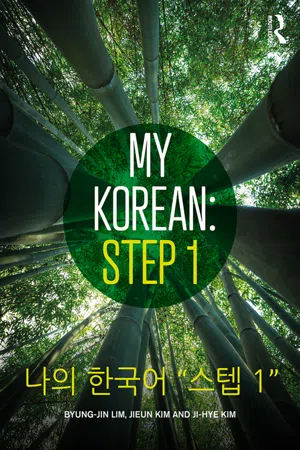
- 182 pages
- English
- ePUB (mobile friendly)
- Available on iOS & Android
About this book
The My Korean series of textbooks offers a learner-centred, communicative task-based, interactive approach to learning contemporary Korean.
My Korean: Step 1 and My Korean: Step 2 are arranged thematically around topics that any novice learner of Korean is likely to encounter in their first year of study. Each lesson contains two dialogues showing contemporary Korean in use, followed by succinct grammar and vocabulary explanations.
The focus throughout the books is on communicative in-class activities and tasks that encourage students' active participation. Video clips of the lesson dialogues are available as an online resource, and each unit contains communicative activities based on the dialogue themes.
The engaging structure and communicative approach make My Korean: Step 1 an ideal text for first semester Korean courses. It is also a great resource for individual study or one-on-one tutorials on Korean language and culture.
Frequently asked questions
- Essential is ideal for learners and professionals who enjoy exploring a wide range of subjects. Access the Essential Library with 800,000+ trusted titles and best-sellers across business, personal growth, and the humanities. Includes unlimited reading time and Standard Read Aloud voice.
- Complete: Perfect for advanced learners and researchers needing full, unrestricted access. Unlock 1.4M+ books across hundreds of subjects, including academic and specialized titles. The Complete Plan also includes advanced features like Premium Read Aloud and Research Assistant.
Please note we cannot support devices running on iOS 13 and Android 7 or earlier. Learn more about using the app.
Information
Part 1
Introduction
About this Korean language textbook
- Student-centered themes with contemporary Korean in use
- Communicative culture-based activities
- Straightforward explanations of grammar and new expressions
- Designs for user-friendly and optimal content delivery
- Basic as well as extended vocabulary with Chinese characters
- Companion website featuring multimedia learning tools
- The current Korean language textbook offers student-centered themes with authentic Korean. From the beginning of the development of the Korean language textbook, students at the authors’ institution participated by expressing their thoughts and needs through questionnaires. Their active participation and input became the basis for the themes in each lesson of the book.
- Each lesson in the book includes two communicative culture-based activities to help students achieve proficiency in the Korean language and culture via active interaction with other students in and outside the classroom.
- The book offers simple and straightforward explanations of grammatical features and new expressions along with sample dialogues to illustrate each grammar point.
- The book is designed with user-friendliness in mind in order to provide optimal learning opportunities for both students and teachers. For example, bigger fonts are used in Lesson 1 while smaller fonts are utilized in later chapters; pages are organized such that students can easily recognize repeated features; colors are selected for readability and aesthetic balance; and English translations of each dialogue are presented adjacent to the dialogues in early chapters while they are deliberately placed at the end for later chapters.
- In response to the growing presence of Chinese-speaking learners of Korean in the world, the book also offers vocabulary (basic or extended) with English glosses along with corresponding Chinese characters for those students (e. g., 일, 이, 삼 ... one, two, three ... 一, 二, 三 ...).
- A companion website has been developed with interactive multimedia materials for all of the dialogues in the textbook.
Structure of the textbook
- Dialogues: Written in contemporary Standard Korean, dialogues provide contexts in which beginning learners of Korean encounter everyday circumstances with their classmates, friends, and instructors from day one at college. Dialogues also present various scenes and contexts where the learners may experience authentic interactions with native speakers of Korean. Students may find it useful to memorize dialogues as they are likely to face them for daily activities in contemporary Korean.
- Grammar and expressions: Grammar used in the dialogues in each lesson is explained in detail using simple and straightforward language. For easy grammar explanation, technical linguistic terminology is deliberately avoided. Instead, simple and detailed explanation is provided for each grammar point for true beginner learners of Korean. Also, new expressions are explained with ample example sentences such that learners can easily study them on their own. At the end of each grammar point, individual practices are also provided. Later chapters (in Part 3) also provide exercises that are based on the explanations of grammar and new expressions. Students are expected to read the “Grammar and Expressions” sections before they come to class.
- Vocabulary (basic and expanded): Each lesson contains basic and expanded vocabulary. Basic vocabulary is used in the dialogues, and expanded vocabulary consists of additionally recommended words that can be further built onto the basic vocabulary. For successful learning, students are expected to study both basic and expanded vocabulary before each lesson is discussed in the classroom.
- Activities: One of the distinguishing features of the textbook is the inclusion of culture-based activities in each lesson. Specifically, through activities, students can compare and reflect on Korean culture as well as their own culture. In addition, each activity revolves around the themes discussed in the dialogues of each chapter.
- Cultural notes: Culture is an impor...
Table of contents
- Cover
- Half Title
- Title
- Copyright
- Contents
- Part 1
- Part 2
- Part 3
- Index